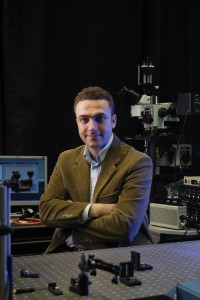 The ubiquity of cell phone technology in today's world, even in developing nations, has opened a door for biomedical researchers to invent diagnostic devices that utilize the cell phone platform to perform analyses that otherwise would require prohibitively expensive equipment. And that is just what the 32-year-old bioengineering prodigy Aydogan Ozcan is doing at UCLA's Biophotonics Lab (also known as the Ozcan Research Group Nano / Bio Photonics Lab, and contributor of the photo at right) in the Samueli School of Engineering and Applied Sciences.
The ubiquity of cell phone technology in today's world, even in developing nations, has opened a door for biomedical researchers to invent diagnostic devices that utilize the cell phone platform to perform analyses that otherwise would require prohibitively expensive equipment. And that is just what the 32-year-old bioengineering prodigy Aydogan Ozcan is doing at UCLA's Biophotonics Lab (also known as the Ozcan Research Group Nano / Bio Photonics Lab, and contributor of the photo at right) in the Samueli School of Engineering and Applied Sciences.
Dr. Ozcan describes his research:
"We have more than 5 billion cell phone subscribers around the world today, and because of this, cell phones can now play a central role in telemedicine applications. Our research group has already created a very nice set of tools, including cell phone microscopes, that can potentially replace most of the advanced instruments used currently in laboratories."
The latest marvel to come out of the Ozcan Photonics Lab is a flow cytometer that attaches to a cell phone and costs about $5 to produce. The device attachment is an "optofluidic platform that integrates imaging cytometry and florescent microscopy," according to a recent UCLA Newsroom article, and "can be used to rapidly image bodily fluids for cell counts or cell analysis." The key to the device's overall function is the camera lens on the phone and the phone's ability to store images on its CMOS sensor-chip. Use of the resulting cytometer does not require cell phone service or a satellite connection at the point of usage, though presumably with such a connection a specialist or doctor at a different geographic location could analyze the sample, either in real time or when a connection became available.

(Above image courtesy of UCLA)
The "telemedicine applications" Dr. Ozcan refers to include a cell-phone-attached microscope called LUCAS that his lab debuted in 2009, and the benefits of which he describes in this video:
LUCAS from SecondMuse on Vimeo
LUCAS was chosen to grace the cover of Lab-on-a-Chip Journal and is an excellent example of what can be accomplished through a reduction in size, complexity, and cost of analytical equipment. Lab-on-a-chip (or LOC) technology can offer all of these advantages over traditional machinery:
- Low fluid volumes consumption (less waste, lower reagents costs and less required sample volumes for diagnostics)
- Faster analysis and response times due to short diffusion distances, fast heating, high surface to volume ratios, small heat capacities.
- Better process control because of a faster response of the system (e.g. thermal control for exothermic chemical reactions)
- Compactness of the systems due to integration of much functionality and small volumes
- Massive parallelization due to compactness, which allows high-throughput analysis
- Lower fabrication costs, allowing cost-effective disposable chips, fabricated in mass production
- Safer platform for chemical, radioactive or biological studies because of integration of functionality, smaller fluid volumes and stored energies
The term disruptive technology is popular now as a way of describing an invention that does something that was formerly impossible or unknown, thereby replacing and making obsolete the previous technology. It's not a given that LOC inventions like Dr. Ozcan's cytometer and microscope will become the industry or laboratory standards. Where they will be absolutely revolutionary is in the field, the clinic, and the developing world where there is currently no comparable tool.
Update January 2012: Prof. Ozcan's microscope won The Scientist magazine's Best Innovation of 2011 award (read the article here).
Biotechnology Calendar, Inc. is a full service event marketing and planning company producing on-campus, life science research tradeshows nationwide for the past 18 years. We plan and promote each event to bring the best products and services to the best research campuses across the country. Visit our website for information about upcoming shows in your area.
One of our biggest events, held bi-annually on the UCLA campus, is the Los Angeles Biotechnology Vendor Showcase™ Exposition. Plan to attend this year on October 6.


